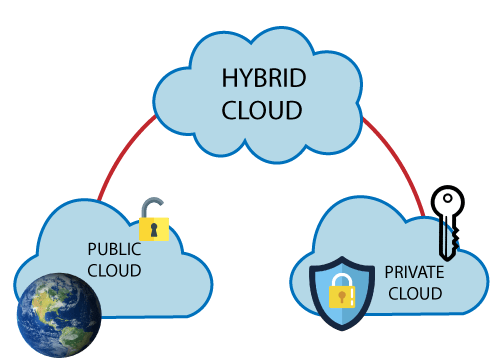As the world has moved towards digitalization in the past decade, cloud computing has become a must-have technology for businesses. From faster speeds and better security to disaster management and cost-reduction, cloud computing offers a number of benefits. However, the number one reason many businesses worldwide adopt the cloud is cloud flexibility. With cloud flexibility and scalability, businesses of all sizes can utilize cloud resources on demand and reduce costs.
But what is cloud computing flexibility? Simply put, flexibility in cloud computing means businesses can scale up and scale down cloud resources depending on their requirements. But the cloud is also flexible in many other ways. Read on to learn about flexible clouds and how Ridge’s Cloud provides the ultimate flexibility. See how it works.
What Are Flexible Clouds?
Flexible clouds are clouds that provide a variety of on-demand computing resources, such as cloud storage. For instance, let’s say your business is growing rapidly, and it starts producing more data. As a result, you’ll need more storage space for the increase in data. Luckily for you, if you are storing your data in the cloud, it is by nature flexible meaning scalable. You can simply ask the cloud provider to increase the storage limit. Similarly, if your business doesn’t need large storage space anymore, you can scale down. The advantage of cloud computing is this scalable flexibility.
In the past, when businesses used traditional IT hosting methods, they had to purchase the required server hardware based on predicted usage. However, this meant when they needed more resources, they had to purchase more hardware. If their resource demand decreased, they would have unused gear, which in turn would mean wasted investment. Also, with traditional IT infrastructure, you have to install a business app on each computer in your office individually. With the flexibility of the cloud, all of these issues are solved, resulting in efficient business operations and reduced costs.
Cloud computing offers flexibility in several ways:
Flexibility in Choosing Cloud Computing Services
There are three main cloud computing services that you can choose from: IaaS, PaaS, and SaaS.

Image source
IaaS (Infrastructure as a Service)
In this cloud computing service model, an organization uses resources provided by a third-party cloud service provider. Storage, virtual private servers, networking, etc., are provided over the internet. IaaS essentially allows businesses to access cloud-hosted infrastructure services without needing to purchase any hardware and other resources. IaaS is also known as a cloud infrastructure service, and it is useful for all types of organizations.
In IaaS, businesses need to create a dashboard, and they can then connect it to the cloud service provider’s API (Application Programming Interface.) The API enables access and allows you to control your data.
PaaS (Platform as a Service)
In this cloud computing model, a third-party cloud provider delivers software and hardware tools, like debuggers, compilers, source code editors, and more. Developers usually use PaaS services delivered via the internet to develop, run and manage custom apps.
In PaaS, the cloud service provider manages and maintains the hardware and software. PaaS speeds up development and reduces development costs.
SaaS (Software as a Service)
SaaS is the most used cloud service model in which a third-party vendor provides ready-to-use cloud-based apps. These apps are delivered over the internet; you don’t need to download a SaaS app as you can access it on your browser over the internet. SaaS is a flexible cloud computing model where apps usually come with different subscription plans. It also offers flexibility in terms of adding data storage or increasing the number of users.
In SaaS, the cloud provider manages the apps and cloud infrastructure, such as servers, data storage, networking, and middleware. SaaS vendors are also responsible for application updates, which are usually not visible to the users.
Flexibility in Adding More Users
The cloud’s flexibility also allows you to add new users to your system as needed. For example, your business may temporarily need freelance workers during certain periods. With the flexibility of cloud computing, you can add more logins without buying and installing any additional software.
With the cloud, you can add users from different locations so that users can remotely access shared files, databases, etc., from their homes using laptops, PCs, or smartphones. This also facilitates collaboration.
Types of Flexible Clouds
The type of cloud flexibility depends on the cloud computing environment. There are three major types of cloud computing environments: public cloud, private cloud, and hybrid cloud. (There is also multi-cloud, but it isn’t as common yet.)
Public Cloud Flexibility
A public cloud is a multi-tenant cloud computing environment that multiple users or organizations can use simultaneously. Each organization’s data and information stay separate, and one organization cannot access the data of the other organization. In a public cloud, the third-party cloud service provider hosts and manages everything. The cloud provider is also responsible for the security and maintenance of the servers.
In addition to computational power, public clouds also offer cloud storage and cloud databases, such as relational and non-relational databases. Businesses can consume cloud resources on demand, increasing and decreasing their resources as needed. This flexibility of public clouds reduces expenses as there is no need to buy more servers when the demand increases. Public clouds also come with flexible pricing.
Private Cloud Flexibility
A private cloud is a single-tenet cloud computing environment where only one organization has access to all the computing resources, hardware, and software. In other words, the computing resources of a private cloud are dedicated to a single organization or customer. However, multiple users from the same organization can access the private cloud.
A private cloud is also known as an internal cloud or corporate cloud. Private cloud servers can be located on-premises or off-premises.
The private cloud lets you transform your IT infrastructure as your IT and business needs change. However, it isn’t as flexible as a public cloud. Although a private cloud offers limited scalability, it provides resource customization and more control over your data, apps, and hardware. Private clouds are best for storing highly sensitive data according to regulatory compliance requirements.

Image source
You can think of a hybrid cloud as a combination of a public and private cloud. Hence, a hybrid cloud is a great way to reap the benefits of both public and private clouds. With a hybrid cloud, you get the flexibility and scalability of the public cloud as well as the security and control of the private cloud.
Organizations using the hybrid cloud usually store their confidential data in the private cloud and less sensitive information in the public cloud. This way, they can easily meet compliance requirements and enjoy the flexible cloud’s infrastructure.
When you’re adopting the hybrid cloud model, you need to ensure your apps are not monolithic. In a monolithic app, everything is connected and built as one unit, so you cannot split it up across different hosting environments. In contrast, if your apps are built using microservices, you can flexibly and easily house different parts in different hosting environments.
Ridge Cloud Flexibility
Ridge Cloud goes beyond the public cloud with a flexible cloud that’s anywhere you need to be. Ridge Cloud integrates into multiple locations and technology stacks to offer a full cloud experience on top of any underlying infrastructure — public or private. Businesses get a cloud customized for their specific throughput, locality, and commercial requirements.
Without any installation or CAPEX, Ridge leverages existing servers and runs application workloads on any IaaS, virtualization, or bare-metal machines. Whether you need to deploy in a private data center, on-prem, edge micro-center, or even in a multi-facility hybrid environment, Ridge expands your footprint without limits.
The Benefits of Using Flexible Clouds
Flexible clouds offer a number of benefits:
Scalability
The biggest advantage of flexible clouds is their scalability. Scalability means you can add more cloud resources to manage big data as your business grows. With such scalability, businesses don’t have to invest in purchasing or maintaining on-premises hardware. Flexible cloud hosting also allows businesses to scale down if needed.
With flexible clouds, you can scale up or down instantly. In contrast, if you’re using a traditional IT infrastructure, you have to wait for some time for your hardware to be delivered.
Reduced Costs
Cloud computing is based on a subscription or pay-per-use model, which is budget-friendly. Additionally, with flexible cloud solutions, you don’t have to purchase, maintain, and update systems and IT hardware, or maintain a high number of IT staff. The service provider maintains and updates the hardware. Cloud solutions reduce labor, storage and power costs.
Customization
Cloud computing is also flexible in terms of allowing customization of cloud services to integrate them into your existing systems. Ridge Cloud is flexible to allow for integration with any underlying infrastructure. As a result, you can improve the functionality of your IT infrastructure across the board.
Remote Access
Cloud services are delivered over the internet. Authorized employees can access the files and data stored in the flexible cloud-based database anywhere at any time. This means flexible clouds facilitate collaboration among employees. They can easily share files and documents with each other from anywhere and work together in real-time. Additionally, users can access the data from any device.
Enhanced Security
While security is sometimes a concern with cloud environments, reliable clouds have strict security protocols in place. Cloud security usually includes:
- Data security
- Threat detection and prevention policies
- Identity and access management
- Data retention plans
- Legal compliance
Flexible Cloud Strategy
Having a flexible cloud strategy means you’re flexible in terms of migrating to the cloud. In fact, one of the best practices of successful cloud migration is to be flexible by analyzing your options. In other words, cloud adoption isn’t based on a “one size fits all” approach.
Here are the key steps of a flexible cloud strategy:
Evaluate Your Needs for The Cloud
Before you decide to migrate to the cloud, you need to evaluate the benefits that cloud computing would provide. While cloud computing is a powerful technology for businesses of all sizes, it could be the most cost effective to continue with your on-premise infrastructure if your data storage needs are stable, consistent, and small, or the most secure if you have hyper-sensitive data.
Decide Whether You Want Partial or Full Transition
Sometimes it’s in the best interest of a business to migrate only some parts of their IT infrastructure. For example, some apps are too complex or data-sensitive to be moved to the cloud, and businesses opt to use a Hybrid Cloud solution.
Decide If You Want to Hire a Managed Service Provider
A managed service provider is a specialist third-party service provider that maintains and manages your IT infrastructure, end-user systems, and network. Managed cloud service providers assume full responsibility for the services they provide.
Decide How Much Data Storage You Need
Once you’ve decided which data you’ll be moving to the cloud, you can choose the amount of storage, RAM and CPU that fit your needs.
Consider Latency Issues
Delayed response times (latency) can be an issue if you’re moving to a public cloud with no cloud servers located near your offices or users. Hence, you should evaluate where the data centers of the cloud provider are located. Ridge Cloud offers connectivity to data centers all over the world with the Anywhere Cloud.
Frequently asked questions (FAQs)
What is flexibility in cloud computing?
Flexibility in cloud computing means organizations can scale up and down as needed without buying any additional hardware. For example, an organization can add more data storage if they start producing more data.
What are the benefits of flexible clouds?
One of the biggest benefits of flexible clouds is scalability. Other benefits of flexible clouds include:
- Cost reduction
- Better collaboration
- Customization
- Remote access
What are the different types of cloud flexibility?
The type of cloud flexibility depends on the cloud computing environment you choose. Three common types of cloud flexibility are public, private, and hybrid cloud flexibility.













